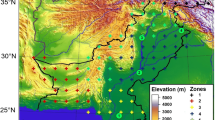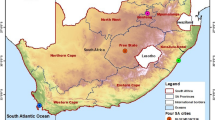Abstract
Regional changes in surface meteorological variables are one of the key issues affecting the Indian subcontinent especially in recent decades. These changes impact agriculture, health, water, etc., hence important to assess and investigate these changes. The Indian subcontinent is characterized by heterogeneous temperature regimes at regional and seasonal scales. The India Meteorological Department (IMD) observations are limited to recent decades as far as its spatial distribution is concerned. In particular, over Hilly region, these observations are sporadic. Due to variable topography and heterogeneous land use/land cover, it is complex to substantiate impacts. The European Centre for Medium-Range Weather Forecasts (ECMWF) ERA-Interim (ERA-I) reanalysis not only covers a larger spatial domain but also provides a greater number of inputs than IMD. This study used ERA-I in conjunction with IMD gridded data to provide a comparative assessment of changing temperature patterns over India and its subregions at both regional and seasonal scales. Warming patterns are observed in both ERA-I and IMD data sets. Cold nights decrease during winter; warm days increase and warm spell duration increased during winter could become a cause of concern for society, agriculture, socio-economic reasons, and health. Increasing warm days over the hilly regions may affect the corresponding snow cover and thus river hydrology and glaciological dynamics. Such changes during monsoon are slower, which could be attributed to moisture availability to dampen the temperature changes. On investigation and comparison thereon, the present study provisions usages of ERA-I-based indices for various impact and adaptation studies.












Similar content being viewed by others
References
Alexander LV, Zhang X, Peterson TC, Caesar J, Gleason B, Klein Tank AMG, Tagipour A (2006) Global observed changes in daily climate extremes of temperature and precipitation. J Geophys Res Atmos 111(D5)
Attri SD, Rathore LS (2003) Simulation of impact of projected climate change on wheat in India. Int J Climatol 23(6):693–705
Archer DR, Fowler HJ (2004) Spatial and temporal variations in precipitation in the upper Indus Basin, global teleconnections and hydrological implications. Hydrol Earth Syst Sci Discuss 8(1):47–61
Berrisford P, Kållberg P, Kobayashi S, Dee D, Uppala S, Simmons AJ, Sato H (2011) Atmospheric conservation properties in ERA-interim. Q J R Meteorol Soc 137(659):1381–1399
Bhutiyani MR, Kale VS, Pawar NJ (2007) Long-term trends in maximum, minimum and mean annual air temperatures across the northwestern Himalaya during the twentieth century. Clim Chang 85(1–2):159–177
Bolch T, Kulkarni A, Kääb A, Huggel C, Paul F, Cogley JG, Bajracharya S (2012) The state and fate of Himalayan glaciers. Science 336(6079):310–314
Compo GP, Whitaker JS, Sardeshmukh PD, Matsui N, Allan RJ, Yin X, Brönnimann S (2011) The twentieth century reanalysis project. Q J R Meteorol Soc 137(654):1–28
Cornes RC, Jones PD (2013) How well does the ERA-interim reanalysis replicate trends in extremes of surface temperature across Europe? J Geophys Res Atmos 118(18):10,262–10,276
Dash SK, Jenamani RK, Kalsi SR, Panda SK (2007) Some evidence of climate change in twentieth-century India. Clim Chang 85(3–4):299–321
Dash SK, Mamgain A (2011) Changes in the frequency of different categories of temperature extremes in India. J Appl Meteorol Climatol 50(9):1842–1858
Dasgupta P, Bhattacharjee D, Kumari A (2013) Socio-economic analysis of climate change impacts on food grain production in Indian states. Environ Dev 8:5–21
De US, Mukhopadhyay RK (1998) Severe heat wave over the Indian subcontinent in 1998, in perspective of global climate. Curr Sci 75(12):1308–1311
De US, Dube RK, Rao GP (2005) Extreme weather events over India in the last 100 years. J Indian Geophys Union 9(3):173–187
Dee DP, Uppala SM, Simmons AJ, Berrisford P, Poli P, Kobayashi S, Bechtold P (2011) The ERA-interim reanalysis: configuration and performance of the data assimilation system. Q J R Meteorol Soc 137(656):553–597
Dimri AP, Dash SK (2010) Winter temperature and precipitation trends in the Siachen glacier. Curr Sci (Bangalore) 9812:1620–1624
Dimri AP, Dash SK (2012) Wintertime climatic trends in the western Himalayas. Clim Chang 111(3–4):775–800
Frauenfeld OW, Zhang T, Serreze MC (2005) Climate change and variability using European Centre for Medium-Range Weather Forecasts reanalysis (ERA-40) temperatures on the Tibetan plateau. J Geophys Res Atmos 110(D2)
Gleason BE, Peterson TC, Groisman PY, Easterling DR, Vose RS, Ezell DS (2002) A new global daily temperature and precipitation data set. In 13th AMS symposium on global change studies, Orlando, FL (pp. 13–17)
Goswami BN, Venugopal V, Sengupta D, Madhusoodanan MS, Xavier PK (2006) Increasing trend of extreme rain events over India in a warming environment. Science 314(5804):1442–1445
Hewitt K (2005) The Karakoram anomaly? Glacier expansion and the ‘elevation effect,' Karakoram Himalaya. Mt Res Dev 25(4):332–340
Hingane LS, Rupa Kumar K, Ramana Murty BV (1985) Long-term trends of surface air temperature in India. J Climatol 5(5):521–528
Jhajharia D, Singh VP (2011) Trends in temperature, diurnal temperature range and sunshine duration in Northeast India. Int J Climatol 31(9):1353–1367
Jones PD, Lister DH, Osborn TJ, Harpham C, Salmon M, Morice CP (2012) Hemispheric and large-scale land-surface air temperature variations: an extensive revision and an update to 2010. J Geophys Res Atmos 117(D5)
Kalnay E, Cai M, Li H, Tobin J (2006) Estimation of the impact of land-surface forcings on temperature trends in eastern United States. J Geophys Res Atmos 111(D6)
Klok EJ, Klein Tank AMG (2009) Updated and extended European dataset of daily climate observations. Int J Climatol 29(8):1182–1191
Kjellstrom T, Kovats RS, Lloyd SJ, Holt T, Tol RS (2009) The direct impact of climate change on regional labor productivity. Arch Environ Occup Health 64(4):217–227
Kothawale DR, Rupa Kumar K (2005) On the recent changes in surface temperature trends over India. Geophys Res Lett 32(18)
Kothawale DR, Revadekar JV, Kumar KR (2010) Recent trends in pre-monsoon daily temperature extremes over India. J Earth Syst Sci 119(1):51–65
Mondal P, Jain M, Robertson AW, Galford GL, Small C, DeFries RS (2014) Winter crop sensitivity to inter-annual climate variability in Central India. Clim Chang 126(1–2):61–76
Nakajima T, Yoon SC, Ramanathan V, Shi GY, Takemura T, Higurashi A, Tsuruta H (2007) Overview of the atmospheric Brown cloud east Asian regional experiment 2005 and a study of the aerosol direct radiative forcing in East Asia. J Geophys Res Atmos 112(D24)
Pal I, Al-Tabbaa A (2010) Long-term changes and variability of monthly extreme temperatures in India. Theor Appl Climatol 100(1–2):45–56
Pal I, Al-Tabbaa A (2011) Assessing seasonal precipitation trends in India using parametric and non-parametric statistical techniques. Theor Appl Climatol 103:1–11
Pant G. B. and K. R. Kumar (1997). Climates of South Asia. Wiley
Pai DS, Thapliyal V, Kokate PD (2004) Decadal variation in the heat and cold waves over India during 1971–2000. Mausam 55(2):281–292
Santer BD, Wigley TML, Boyle JS, Gaffen DJ, Hnilo JJ, Nychka D, Nychka NKE (2000) Statistical significance of trends and trend differences in layer-average atmospheric temperature time series. J Geophys Res Atmos 105(D6):7337–7356
Sen PK (1968) Estimates of the regression coefficient based on Kendall’s tau. J Am Stat Assoc 63(324):1379–1389
Seneviratne SI, Nicholls N, Easterling D, Goodess CM, Kanae S, Kossin J, Luo Y, Marengo J, Mclnnes K, Rahimi M, Reichstein M, Sorteberg A, Vera C, Zhang X (2012) Changes in climate extremes and their impacts on the natural physical environment. In managing the risks of extreme events and disasters to advance climate change adaptation. In: Field CB, Barros V, Stocker TF, Qin D, Dokken DJ, Ebi KL, Mastrandrea MD, Mach KJ, Plattner G-K, Allen SK, Tignor M, Midgley PM (eds) A special report of working groups I and II of the Intergovernmental Panel on Climate Change (IPCC). Cambridge University Press, UK, New York, pp 109–230
Sheikh MM, Manzoor N, Ashraf J, Adnan M, Collins D, Hameed S, Islam N (2015) Trends in extreme daily rainfall and temperature indices over South Asia. Int J Climatol 35(7):1625–1637
Shepard D. (1968). A two-dimensional interpolation function for irregularly-spaced data. In Proceedings of the 1968 23rd ACM national conference (pp. 517–524), ACM
Sellers WD, Liu W (1988) Temperature patterns and trends in the upper troposphere and lower stratosphere. J Clim 1(6):573–581
Simmons A. J., P. D. Jones, V. da Costa Bechtold, A. C. M. Beljaars, P. W. Kållberg, S. Saarinen, and N. Wedi (2004). Comparison of trends and low-frequency variability in CRU, ERA-40, and NCEP/NCAR analyses of surface air temperature. J Geophys Res Atmos, 109(D24)
Simmons AJ, Willett KM, Jones PD, Thorne PW, Dee DP (2010) Low-frequency variations in surface atmospheric humidity, temperature, and precipitation: inferences from reanalyses and monthly gridded observational data sets. J Geophys Res Atmos 115(D1)
Srivastava AK, Rajeevan M, Kshirsagar SR (2009) Development of a high resolution daily gridded temperature data set (1969–2005) for the Indian region. Atmos Sci Lett 10(4):249–254
Wang XL, Swail VR (2001) Changes of extreme wave heights in northern hemisphere oceans and related atmospheric circulation regimes. J Clim 14(10):2204–2221
Yadav RR, Park W-K, Singh J, Dubey B (2004) Do the western Himalayas defy global warming? Geophys Res Lett 31 no. 17
Zhang X, Alexander L, Hegerl GC, Jones P, Tank AK, Peterson TC, Zwiers FW (2011) Indices for monitoring changes in extremes based on daily temperature and precipitation data. Wiley Interdiscip Rev Clim Chang 2(6):851–870
Zhang X, Zwiers FW, Li G (2004) Monte Carlo experiments on the detection of trends in extreme values. J Clim 17(10):1945–1952
Acknowledgements
The author acknowledges financial support provided by the British Council in the form of Commonwealth Fellowship. The author also acknowledges Dr. C. Goodess, Climate Research Unit, University of East Anglia, Norwich, UK, and Dr. R. C. Cornes, The Royal Netherlands Meteorological Institute (KNMI), Netherlands. The author acknowledges Ms. Dallas Stanley for comprehensive English edits.
Author information
Authors and Affiliations
Corresponding author
Rights and permissions
About this article
Cite this article
Dimri, A.P. Comparison of regional and seasonal changes and trends in daily surface temperature extremes over India and its subregions. Theor Appl Climatol 136, 265–286 (2019). https://doi.org/10.1007/s00704-018-2486-5
Received:
Accepted:
Published:
Issue Date:
DOI: https://doi.org/10.1007/s00704-018-2486-5




